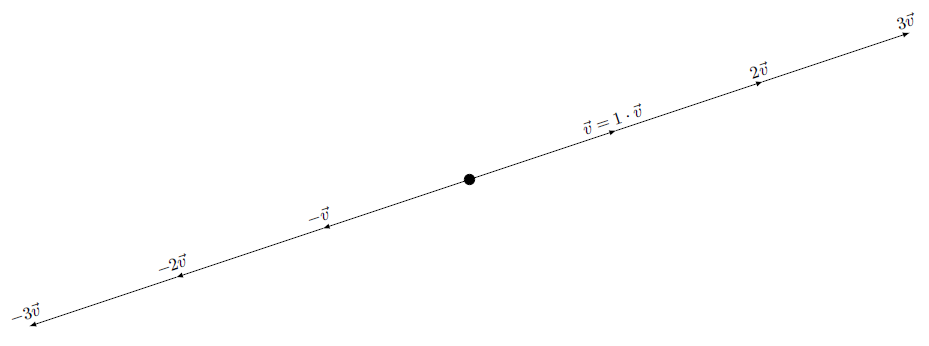Vector calculus in plane and space: Vectors in Planes and Space
 Scalar multiplication
Scalar multiplication
Scalars
We use \(\lambda \cdot\vec{v}\) to the denote the vector that originates from the vector #\vec{v}# by multiplying it from its starting point with a number #\lambda#, provided that the direction of the vector #\vec{v}# is first reversed as #\lambda \lt 0#.
In other words: \(\lambda \cdot\vec{v}\) is the vector whose
- length is #\left|\lambda\right|# times the length of #\vec{v}#, and
- direction is equal to that of #\vec{v}# if #\lambda\gt0#, and is equal to that of #-\vec{v}# if #\lambda\lt0#.
We call #\lambda \cdot\vec{v}# a scalar multiple of #\vec{v}#, or simply multiple of #\vec{v}#. The (scaling) number #\lambda# which we use to multiply the vector, is called a scalar (plural: scalars). Usually we write
- #\vec{v}# rather than #1\cdot\vec{v}#,
- #-\vec{v}# rather than #(-1)\cdot\vec{v}#,
- #-3\cdot \vec{v}# rather than #(-3)\cdot\vec{v}#, and so on.
The vector #-\vec{v}# is also called the opposite of #\vec{v}#.
In the figure below, the vector #\vec{v}# and single scalar multiples, all positioned at the origin, is portrayed.

Sometimes the multiplication point is omitted in the scalar multiplication, as in #3 \vec{v}# or #3\rv{-7,9}#, but we generally strive for a properly-denoted point. The scalar is always to the left of the vector.
Scalar multiplication in coordinates
For #\vec{v}# in #\mathbb{R}^2# the scalar multiplication with #r# is given by
\[ r\cdot\rv{x,y}=\rv{r\cdot x,r\cdot y}\tiny.\]
For #\vec{v}# in #\mathbb{R}^3# the scalar multiplication with #r# is given by
\[ r\cdot\rv{x,y,z}=\rv{r\cdot x,r\cdot y,r\cdot z}\tiny.\]
The following case is discussed #{\mathbb R}^2#. The proof for #\mathbb{R}^3#, the space, is not essentially different.
We must show that # \rv{r\cdot x,r\cdot y}# coincides with #r\cdot\vec{v}#. If #r=0#, then #\rv {r\cdot x,r\cdot y}=\rv{0,0}=\vec{0}#. On the other hand, #0\cdot\vec{v}# is also equal to #0\cdot \vec{v}#, because the length of #0\cdot \vec{v}# is equal to #0#, and #\vec{0}# is the only vector with a length equal to #0#.
For the remaining proof, we can assume that #r\ne0#. In order to conclude that # \rv{r\cdot x,r\cdot y}# and #r\cdot\vec{v}# coincide, noting that both vectors have the same length and direction is sufficient.
- The length of # \rv{r\cdot x,r\cdot y}# is equal to \[\sqrt{(r\cdot x)^2+(r\cdot y)^2}=|r|\cdot \sqrt{x^2+y^2}\tiny,\], so #|r|# times the length of #v#. This is the length of #r\cdot\vec{v}#.
- We distinguish two cases.
- If #r\gt 0#, then the direction of # \rv{r\cdot x,r\cdot y}# is equal to that of #\rv{x,y}#.
- If #r\lt0#, then the direction is equal to that of #\rv{-x,-y}#, the direction of the vector represented by the segment that starts at the origin and ends at #\rv{-x,-y}#, and is also represented by the line segment starting at #\rv{x,y}#, and ending at the origin; this is the direction of #-\vec{v}# and, therefore, also of #r\cdot\vec{v}#.
In both cases, the direction of # \rv{r\cdot x,r\cdot y}# is, therefore, equal to that of #r\cdot \vec{v}#.
Calculation rules for scalar multiplication
The following calculation rules apply to scalar multiplication, where #\vec{v}# is a vector and #\lambda#, #\mu# are scalars.
- #0\cdot \vec{v} = \vec{0}#
- #\lambda\cdot\vec{0}=\vec{0}#
- #\lambda\cdot (\mu\cdot \vec{v}) = (\lambda \cdot\mu) \cdot\vec{v}#
- #-\left(\mu\cdot\vec{v}\right)=\left(-\mu\right)\cdot\vec{v}#
The third line in words: if you first multiply the vector #\vec{v}# by #\mu#, then multiply the outcome by #\lambda#, the result is equal to the vector you obtain by multiplying #\vec{v}# by the product #\lambda\cdot\mu#.
The first line has already been derived above: #0\cdot \vec{v}# has a length of #0#, and #\vec{0}# is the only vector with that property.
The second rule also follows from the observation that #\vec{0}# is the only one vector with a length of #0#.
The third line now immediately follows from first if #\lambda# or #\mu# equals #0#, because then both sides are equal to #\vec{0}#. If this is not the case, then we can derive the equality by stating that there are vectors with the same direction and length to the left and right of the equality.
- When multiplying, the direction can only change if the symbol of the scalar is negative. Because the left and right scalars occur an equal number of times, the directions on the left and right are equal.
- The length of the vector on the left is #|\lambda|\cdot |\mu|# times the length of #\vec{v}#. But that is the case on the right as well. The lengths of #\lambda\cdot (\mu\cdot \vec{v})# and # (\lambda \cdot\mu) \cdot\vec{v}# are, therefore, also equal.
The fourth line follows from the third with #\lambda = -1#:
\[-\left(\mu\cdot\vec{v}\right) = (-1)\cdot \left(\mu\cdot\vec{v}\right) =\left((-1)\cdot \mu\right)\cdot\vec{v}=\left(-\mu\right)\cdot\vec{v}\tiny.\]
The scalar multiplication in coordinates gives \[\begin{array}{rcl}-2\cdot\rv{-2,-1,-4}&=&\rv{-2\cdot -2, -2 \cdot -1, -2\cdot -4}\\
&=&\left[ 4 , 2 , 8 \right]\end{array}\] In the figure below, #\vec{v}# is the line segment drawn in black from the origin to #A#, and #r\cdot \vec{v}# is the line segments drawn in red from the origin to #B#.


Or visit omptest.org if jou are taking an OMPT exam.



